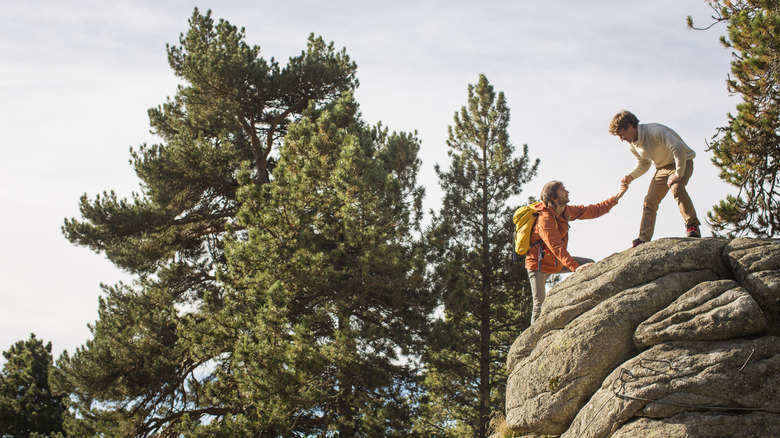The Hiking Trail Etiquette Mistake You're Probably Making
With hiking trails becoming more crowded since the pandemic increased the world's appreciation of outdoor activities, it is now more important than ever to pay attention to and follow hiking etiquette rules so that everyone can enjoy themselves without impacting the enjoyment of others. There are quite a few hiking etiquette rules that are no-brainers and that most everyone already knows — such as picking up after ourselves, leaving no trace, being compassionate to others, and more. However, there is one rule that you may not be aware of, and it has to do with who has the right of way on the trail: the people hiking uphill or those hiking downhill.
While this right-of-way courtesy may not matter on flat hikes, it is a very important consideration on trails that are steep or have a lot of switchbacks because those hikes can be dangerous when crowded. Therefore, it's essential to know who should step aside and who should keep walking. According to the National Park Service, the person who has the right of way in this situation is the one walking uphill. While this may be the opposite of what you expected because the person going downhill has more momentum, there's a very good reason why the rule favors uphill hikers.
Why the downhill hiker should give way
There are a few reasons why hikers going uphill have the right of way and why downhill hikers should step aside. The first is that, on steep inclines, uphill hikers have a smaller field of vision and can't necessarily see who is up ahead as easily as downhill hikers. Furthermore, hiking uphill is more difficult and takes more energy. So, if a downhill hiker pauses and steps to the side it will be easy for them to start walking again after the other hikers pass. However, if an uphill hiker is forced to stop and give way, it may completely break their momentum and it will be harder for them to get going again.
Of course, there may be times when an uphill hiker stops and lets downhill hikers pass. However, as REI notes, this choice is completely up to the uphill hiker and whether or not they want to stop and take a break or continue their trek uphill. If an uphill hiker stops and steps to the side, then it is completely acceptable to pass by them. However, if the uphill hiker looks like they want to keep going, it is the downhill hiker's responsibility to step aside.
Other trail etiquette mistakes you might be making
Besides the uphill-downhill hiking etiquette rules, there are also other simple trail etiquette mistakes you may be making without even knowing it. The first involves hiking with your furry best friend. When on the trail with a dog, we all know that it is important to clean up after any bathroom poo breaks they take on the trail. This is necessary because dog poop can be not only annoying for other hikers but is also bad for the environment. Furthermore, it is also important to know that if you are hiking with a dog, it is your responsibility to pull your dog to the side and let other hikers pass by because not everyone is comfortable around dogs.
Although it has become rather popular today, building rock towers — often called cairns — is also against the rules in many national and state parks. This is because cairns, although pretty, damage the environment. In a similar vein, it's also important not to take any souvenirs like rocks, soil, flowers, and other natural items out of parks. This is because, while one rock may not make a difference, when many people take items it can have a detrimental impact on the environment and ecosystem of the area.


